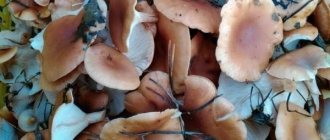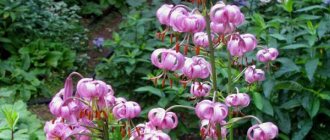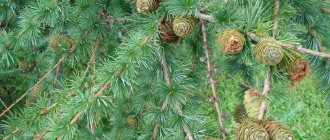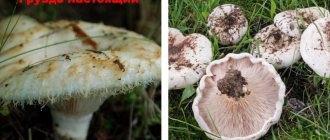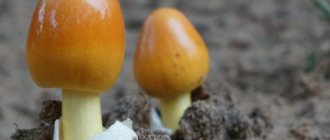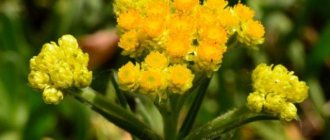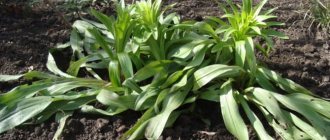Origin
Under natural growing conditions, curly lily can be found in hornbeam, oak and deciduous forests of the European part of the mainland. The heat-loving plant has so much vital energy that it was able to adapt to the cold climate and settled in mountainous areas and glacial valleys. The distribution area became wider and wider every year. Now the curly lily is widespread in Siberia, the Far East, and Transbaikalia.
Homeland of saranka
Name
European breeders paid attention to the curly lily back in the 18th century. At that time, it was considered a divine flower and was grown only in greenhouses and artificial gardens. Thanks to modern breeding work, several varieties and hybrid varieties of the plant have been developed.
People call the curly lily the saranka, and scientists gave it a sonorous name - “Martagon”, which translated means “Lily that gave birth to Mars”. The Latin name is Lílium mártagon.
Other names for lilies are also known: royal curls, ringing forest bell, golden root, forest lily.
Description
The curly lily is popularly called saranka, masala, royal curls, and forest lily. The flower is a perennial plant whose height reaches 1.5 meters. The stem has a round shape and has red spots on it. Saranka flowers grow from bulbs formed by fleshy, yellow, scale-shaped leaves. Their diameter can reach 8 centimeters.
The lower part of the stem is covered with oblong median leaves, collected in whorls of several pieces. Up the stem they have a regular arrangement. The leaves are 15 centimeters long and 5 centimeters wide and have smooth edges. Drooping inflorescences have the shape of a turban. Petals with spots on them are colored in orange, violet, purple shades. They are bent back, starting from the base. The fruit has the shape of a hexagonal box. Flat seeds with films around the edges are triangular. Their color is brown, with different shades. The flowering period begins at the end of June and lasts several weeks. Growing in a sunny area, the plant produces up to 20 flowers. Curly lily is a frost-resistant plant. It is successfully cultivated in the harsh climate of Siberia.
Red saranka, curly lily will help from wounds
Since ancient times, red locust, growing in the steppe, has been used by the peoples of Buryatia and Mongolia as a medicinal raw material.
The healing properties of saranca and lilies were used to relieve toothache, treat wounds and other diseases.
In Transbaikalia, its bulbs are eaten raw, boiled, and baked. It is mercilessly exterminated, so this plant is taken under protection and listed in the Red Book.
Each person has special attachments to this or that time of the year, to a small particle of native nature that has once sunk into memory.
Spring or early summer…what associations do you have, what do you remember? And now I remember spring and the beautiful flower lily, or rather its bulb.
This is an extraordinary flower of meadows and lowland areas; it grows in Transbaikalia and Eastern Siberia.
Memories go back to childhood, to a distant Siberian village. All the children were looking forward to the start of spring field work. When the tractors went out into the field and began to plow the collective farm arable land, all the children rushed after... Why, you might think? But more on that later…
Botanical description of saranka
And now I want to return to the red locusts, the scientific name of the flower is curly lily. The plant is perennial, 10-15 cm tall.
In the upper part, the stem branches a little, so 2-5 medium-sized red flowers bloom at the top, with curly petals strewn with small black dots, some without dots.
The flower, shaped like a turban, exudes a unique, sweet-spicy aroma.
By the way, I went through all the descriptions of the curly lily, almost all sources describe the lily, with lilac-purple flowers. In our region, it is the bright red one that grows.
The red curly lily, like all lilies, forms a bulb instead of a root, consisting of many juicy and fleshy scales. It was the sweet bulb of this medicinal plant that attracted children in early spring.
When plowing, the tractor turned over layers of earth with a plow, and then, behind the plow, a harrow was pulled, which broke the earth and it became soft and fluffed up, like a feather bed...
And the children were already running behind the harrow. White locust bulbs, reminiscent of garlic heads, appeared on the surface and were clearly visible on the black soil.
Having eaten until we were full and filled our pockets full, we returned home happy and joyful, without realizing that we were causing irreparable harm to this population.
An old Siberian legend tells that the saranka bulb arose from the heart of the Cossack chieftain Ermak, who died in the 16th century on the Irtysh in a battle with Khan Kuchum.
Composition, beneficial properties
Fresh lily bulbs are edible both raw and cooked. The bulbs have a pleasant sweetish taste; they were used to cook soup and porridge with milk. Boiled onions somewhat resemble potatoes in taste, but have their own unique and special flavor.
In summer, when the flowers bloom, their bright corollas signal with their red color and become noticeable from afar. Traditional medicine recommends collecting flower corollas and making decoctions from them, or brewing vitamin tea. From childhood, I remember many medicinal plants not only by their appearance and smell, but also by their taste.
Source: https://monamo.ru/rasteniya/krasnaya-saranka-ot-ran-i-boli
Landing rules
When you decide to plant Saranka lily, you can buy seeds or a ready-made plant. It is better to plant it immediately in a permanent place; the flower does not really like transplantation and can take a long time to get used to. A slightly shaded place for planting is suitable, preferably with a sliding shadow, near bushes. The soil should be loose, never acidic, with good drainage. if the soil is sandy and prone to drying out, then it is worth adding clay soil. If the soil is heavy, it can be diluted with peat, compost, and humus. This improves the air supply to the roots and creates comfortable conditions.
Lily seeds are triangular, flat, light brown. They ripen in early August. They are sown to a depth of about 2 cm in the winter or in early spring, as soon as it thaws. If planting in autumn, it is better to mulch the soil with humus to a layer of 10–15 cm. In spring, it is necessary to prepare the seeds for planting. In about 60 days, the seeds are placed in a moist substrate (moss, sand or peat) and kept at a temperature of about 0°. The type of germination of the Saranka lily is underground, and this system allows the formation of a bulb with roots. When planting such a bulb, you should be patient. In the best case, a leaf will grow at the end of summer, but its germination may take until next year. Then a stem and several leaves are formed - a whorl. Flowers appear after another year or two. And then the Saranka lily annually pleases with bright, unusual flowers.
The flower can be propagated by rooting bulb scales. Immediately after the lily has bloomed (in early August), it is carefully dug up, the outer scales are separated, and then the main bulb is planted back. “Children” are placed in a box with prepared soil, for which turf, sand and humus are mixed in a ratio of 2: 1: 1. To create a microclimate, the soil is sprinkled with peat, covered with film and placed in the shade. At the beginning of autumn, bulbs with leaves are formed, which can already be planted. It is better to cover the plantings with hay for the winter, a layer of 10–15 cm.
Saranka lilies: how to grow a curly lily on Supersadovnik.ru
I became acquainted with the lily-saranka as a child. Moreover, we didn’t tear it into bouquets, didn’t grow it, but... ate it. Those who are lucky enough to live near the forest know how many delicious things, in addition to strawberries and raspberries, can be found there. But if the lungwort’s flowers were really sweet and honey-like, the taste of the locust bulbs was disappointing.
Many years later, at a country flower market, we came across a curly lily (Lilium martagon), which I hardly recognized as a forest locust from childhood. Tall, human-sized stems were crowned with slender inflorescences of numerous snow-white flowers with a strong spicy aroma. This is where our passion began.
The closer you get to know the culture, the more forms and varieties you want to try in your garden. Here lies, perhaps, the only problem of those who decided to decorate the garden with martagon lilies: it is difficult to find planting material.
This species reproduces reluctantly and slowly increases the size of the bulb, so very few nurseries are engaged in industrial breeding; the bulbs are expensive, and it is quite difficult to obtain them from Europe or America.
Favorite varieties
The unique quality of these lilies is that they are both showy and graceful. Of the natural forms, the most beautiful, in my opinion, are white without specks on the petals (var. album) and Cattani, also Dalmatian (var. cattaniae, var. dalmaticum), with dark red flowers.
Hybrids of various natural and garden forms with other types of lilies - Tsingaut, Hanson, honey-shaped - have produced varieties that are stunning in diversity and beauty. In total, about two hundred of them are registered.
Black Prince has the darkest, purest red flowers (height 1.1 m); the variety reproduces extremely slowly. Early Bird (1.7 m) with very fragrant flowers, on the contrary, is characterized by relatively fast growth and produces daughter bulbs well.
The flowers open bright orange-pink, then turn fawn.
Tsingense (1.5 m) has a characteristic tufted flower shape in a cheerful orange tone. One of my favorites, Ivorine (1.2 m), is the epitome of nobility. White flowers with a light grayish-pink shadow look like porcelain pagodas, the petals have a very dense texture. Terrace City (1.5 m) has yellow flowers, while Bronze Medallion (1.6 m) has bright bronze flowers in large inflorescences.
The color of the flowers of the Attiwaw variety (1 m) contains several shades of pink and gold. Pink Attraction is also relatively low (1.2 m). This variety has numerous large flowers of rich pink color with expressive dark red specks.
Selecting a location
To plant these lilies, choose a fairly light, well-drained area. The soil needs to be worked deeply, two shovels deep.
We have sandy soils that dry out easily, so when preparing the soil we increase its moisture capacity by adding clay soil or laying a layer of clay on the bed of the flower bed.
On heavy soils, on the contrary, it is worth improving aeration, loosening the soil by adding peat, compost, and humus. Fresh manure cannot be used.
Landing
In the conditions of North-West Russia, the best time for planting is from mid-August to mid-September. In practice, it turns out that we plant when we get the bulbs: on time, in late autumn, and in spring.
It is better to mulch autumn plantings with loose organic material (leaf humus, peat) in a layer of 10–15 cm. Bulbs purchased in the spring are planted as soon as the soil thaws. In the first year, plants usually do not reach the height characteristic of the variety and bloom weakly.
After spring planting, the martagon may not even appear at all or will form a short stem and go dormant in mid-summer. This is normal, the bulb needs time to take root well.
It is better to plant martagons immediately in a permanent place, and if replanting is still necessary, you should try to preserve the root ball as much as possible.
Good planting material is large, strong bulbs with intact scales, in a dormant state. If the bulbs are dry, they can be kept for 2-3 hours in a solution of Zircon or Epin, and then planted.
When planting is postponed, we store the bulbs in a cool (in spring - in a cold, 0 ... + 1 ° C) place, in slightly damp perlite or peat. The planting depth of an adult bulb is 20–25 cm, counting from the bottom. We plant small bulbs not so deep, 10–15 cm.
The roots should be freely spread, the soil should be well drained after planting.
Care
The feeding scheme is usual: in the spring, complete mineral fertilizer, after flowering - potassium-phosphorus. Watering - deep, at the root. Regular mulching with organic matter can easily replace fertilizing.
Diseases and pests
Martagons rarely get sick, but on poorly ventilated plantings during particularly wet and cold seasons, botrytis may appear - gray-brown spots on the leaves. For prophylaxis, use Fitosporin 2-3 times, with an interval of two weeks. In case of disease development, systemic fungicides Topaz and Skor help well.
Of the pests, the most annoying damage is caused by the lily fly: damaged buds fall off without blooming, or open into deformed flowers. Such buds are collected and destroyed. In the next season, starting from May, lilies are sprayed 2-3 times with the Aktara insecticide at intervals of 2 weeks.
Lily propagation
The most effective method of propagating martagon lilies is scaling. In the fall, several outer scales are separated (there is no need to dig up the bulb), washed, disinfected with a fungicide (Maxim, Vitaros) and kept in slightly damp perlite or chopped sphagnum at room temperature. After about 2 months, bulbs form at the base of the scales.
The scales with bulbs are placed in a cool place and planted in the garden in the spring. It is more convenient to plant shallowly in boxes or bowls that are dug into the ground and lightly covered for the winter. The scales are not forcibly removed.
They continue to feed the bulb further, while it grows roots. It happens that the scales survive even before planting in the ground without drying out - then we plant them directly with them.
If the scales begin to rot, cut off the damaged areas and coat the sections with brilliant green.
The speed of bulb development depends on the variety; on average, you will have to wait 4–5 years for flowering. Seedlings bloom on average in the seventh year.
Illustrations for the material: shutterstock
RELATED MATERIALS
You will not regret purchasing oriental lilies. When they bloom, your neighbors, friends and acquaintances...
Although it is believed that bulbous plants can be planted almost anywhere, they still have their own...
When choosing bulbous flowers, you can focus only on their decorative qualities, but you can approach...
You will not regret purchasing oriental lilies. When they bloom, your neighbors, friends and acquaintances...
The oldest wish for well-being says: “May your path be strewn with roses and lilies.” ...
Some lilies - Asian, trumpet, oriental hybrids - prefer open sunny...
Lilies are propagated by vegetative and seed methods. There are several vegetative methods: division...
Dividing lily nests is the easiest method of propagation, but also the least productive.
Lilies are propagated by vegetative and seed methods. But the latter is used mainly by specialists...
Asian lily hybrids can be propagated by bulbs.
Source: https://www.supersadovnik.ru/text/lilii-saranki-lichnyj-opyt-1003281
Features of care
After flowering, the stem dies and must be removed. The bulb calmly endures winter in the ground. You can insulate it with sawdust or leaves, and feed it with ash in the spring.
It is important to weed in time and avoid excessive shading of lilies.
In this case, the sprouted stems stretch out and spread, the flowers are small and pale. Moderate watering is required. Avoid overwatering, as the bulbs may rot. Having established itself in place in the first year or two, the Saranka lily does not require any special care in the future, other than ordinary manipulations. And it becomes a harmonious part of country landscape design.
Pests and diseases
Lilies can be harmed by a variety of insects. The thing to be most wary of is the lily fly, which lays larvae in the buds. As a result, the flowers never open, die, or lose their shape.
Other pests are:
- Click beetles;
- Squeak beetle;
- Khrushchi;
- Onion root mite;
- Spider mite;
- Aphid;
- Thrips;
- Winter armyworm.
The use of insecticides will help fight insects: Inta-Vir, Iskra, etc. They are safe for plants and harmful to insects.
With proper planting and proper care, the Saranka lily is quite resistant to temperature changes and is little susceptible to infections. Diseases can result from prolonged hypothermia in the summer months, or from days of heavy rain. By the appearance of the stems, flowers and leaves, you can immediately notice manifestations of the disease. The lily is most susceptible to various types of rot:
- Gray mold (also called gray mold, mold fungus), scientific name botrytis;
- Soft (bacterial rot);
- Root rot.
The manifestations of the disease are similar: yellow and brown spots appear on the stems or buds, flowers and leaves dry out and fall off. When the bulb is damaged, a depressed, softened spot appears on it, and an unpleasant odor is released. If the bulb gets sick not during storage, but in the garden, then the ground part of the flower turns yellow and dies. Affected bulbs must be destroyed, and stems, leaves and flowers must also be cut and burned. To prevent these diseases, before planting, the bulbs can be disinfected - treated with Fitosporin solution. You can also treat the soil in the fall, before planting. For this purpose, special preparations are used: topsin-M, benlate, HOM, OXYCHOM.
The Saranka lily is less susceptible to other flower diseases: fusarium, spotting, rust, sclerotial rot. In these cases, the named drugs and solutions also help.
With proper care and choosing a comfortable place, the Saranka lily will delight you with bright and unusual flowers. Harmoniously combined with shrubs, it will create unique beauty in your dacha.
Beneficial features
Saranka is a honey plant. In cooking, it is used as a seasoning for meat dishes; the bulbs can be fried, boiled, baked and eaten raw. In addition, saranka is a medicinal plant; all its parts have healing properties. In April, bulbs are harvested, in June they begin to collect stems and leaves, and flowers are also harvested at this time. The cut raw materials should be laid out under a canopy, making sure that they are not exposed to sunlight. Medicines should be stored in paper bags. The bulbs are rich in vitamins and minerals, contain proteins, alkaloids, ascorbic acid, flavonoids, iron, and sugar. But the chemical composition of saran bulbs has not been fully studied.
Locust bulb
You can prepare decoctions, infusions and tinctures from the curly lily. The juice is used to treat wounds, inflamed skin areas, and burns. Used to treat trophic ulcers.
UchPortfolio.ru
Lily curly
, or
Curly Locust
, or
Tsar's Curls
, or
Forest Lily
(lat.
Lílium mártagon
) is a perennial bulbous plant; species of the genus Lilia.
The curly lily is known by the popular names royal curls, sardana, saranka and sarana, badun, maslanka.
Due to the fact that the species needs protection, protective measures have been taken. The curly lily is a rare species of the flora of the Urals, listed in the regional report of Siberia (1980), the report of rare plants in Central Siberia (1979) and in the Red Book of Transbaikalia ,
The plant is included in the Red Book of Ukraine and recommended for inclusion in the Red Book of Kazakhstan. It is protected on the territory of a number of nature reserves.
Lily is a symbol of ecological purity and beauty of nature. Lily saranka is now rarely found both in nature and in gardens.
The Latin name for saranka is “martagon”, that is, “the lily that gave birth to Marth,” the god of war. The Russian name “saranka” comes from the Turkic “sary”, which means “yellow” - the bulbs of this lily are really yellow.
The Yakuts call the Daurian lily sardaana. Worshiping the surrounding nature, the Yakuts, when choosing children's names, very often turn to the name of this flower - “Sardaana” - lily. One of the most famous television programs in the Sakha Republic bears the same name. A scarlet lily (sardaana) with a gold core on a green stem, thinly bordered with gold, was introduced into the coat of arms of the Amga ulus (Yakutia).
Use of the saranka lily since ancient times
There are many stories, traditions, and legends associated with lilies.
The martagon lily, according to ancient Roman legend, helped warriors become courageous and brave. When going to battle, legionnaires took martagon bulbs with them and ate them before battles, while their fatigue disappeared and confidence in victory appeared. A very similar legend existed in Siberia.
She talked about how the saranka lily was born from the heart of a warrior who bravely defended his land from enemy attacks. And if the bulb of this lily is taken to the battlefield, it will protect against death in battle. And if you also eat it, your heart will be filled with courage, and the warrior will become invincible. The Persians have a similar legend.
Who knows, maybe the sarniki really gave courage to the rebellious archpriest Avvakum, who served exile in Eastern Siberia and accepted a heroic death. Living in Transbaikalia, the exiled archpriest prepared bulbs of this lily for his family.
It is possible that locust bulbs really give confidence to a person, because the alkaloids of this plant are still poorly studied...
According to legend, his widow Hoelun and his son Temujin, who was later proclaimed the Divine Genghis Khan, ate saranka after the death of Yesugei-Bagadur, who were in poverty. But it is unlikely that the memories of a hungry childhood were pleasant for Genghis Khan.
A certain role in the love for this plant was played by the gastronomic preferences of the indigenous peoples of Siberia, for whom sarana was a familiar product, the same as potatoes for us. Thus, the Buryats, Tofalars, and Orochs carried out a massive collection of saran bulbs in the fall, which were stored in dried form.
In Rus', saranka was dug on Yegoryev spring day. Sarans were eaten raw (they taste like unroasted chestnuts), but more often they were boiled in milk or baked in ash. Often the sweet and mealy-tasting saran root replaced bread.
Five to six lily bulbs are enough to satiate an adult.
According to the medieval Persian historian Rashid ad-din, the poor even paid for the bride price with saran roots. Sarana was also used during religious ceremonies.
Thus, during the Tol-ard holiday, the Nivkhs appeased the spirit of water with dishes made from saranka roots and other forest herbs.
At the same time, the Nivkhs put treats on the water and said: “Spirit of water, do not be offended by us, bring us good luck and a lot of fish and sea animals.” This custom has survived to this day.
Why were saran bulbs and rhizomes of medicinal peonies so attractive to ancient peoples? The answer to the question becomes obvious if you become familiar with the medicinal properties of these plants.
Sarana was used not only for food, it was especially valued as a healing agent that raised people weakened after illness to their feet. Bulbs, stems, leaves and flowers of lilies were used as medicinal raw materials. Wounds were healed with saran juice. Chopped and boiled onions with flour were used to open abscesses.
Meat seasoned with saran bulbs was easier to digest. An excellent dietary dish for ulcer sufferers in Buryat cuisine is saran stewed in sube (sube is an oily whitish liquid that remains after melting butter).
The ghee was drained, then the peeled and washed saran tubers were placed in the sube and cooked until a homogeneous thick mass was formed. Then it was cooled, cut into slices and served. This same dish relieved coughs in children.
Dried saranka was used as a healing additive in meat and fish dishes.
https://www.youtube.com/watch?v=VlX7qxh9070
In Trans-Baikal cuisine, saranka bulbs were added to cottage cheese with bird cherry flour. This lily is still popular in Kalmykia and Kyrgyzstan. There, its bulbs serve as a seasoning for sheep's cheese, to which they impart not only a subtle aroma, but also an excellent taste.
During the war, saran bulbs were dried, crushed, and the resulting flour was used to bake bread or cook porridge.
Modern medicine confirms that preparations from lily saranka have anti-inflammatory and calming effects.
They are used as an analgesic and hemostatic agent for gynecological diseases. Lily bulbs are widely used for inflammation of the rectum and bladder.
Therefore, saranks for horsemen served as an effective anti-hemorrhoidal remedy.
In modern oriental medicine, an alcohol tincture prepared from the stem, leaves and flowers of a fresh plant, cut during flowering, is used for inflammation of the ovaries, sexual arousal with cardiac disorders. Lily bulbs are used for functional disorders of the heart and weakened vision. Lily juice is useful for stomach ulcers. Flowers cleanse the kidneys and cure their diseases. A decoction of flowers is drunk for diseases of the gallbladder.
In modern oriental medicine, an infusion of lily bulbs is used. To do this, brew a 15-gram onion in 1 glass of boiling water; leave, wrapped warmly, for 15 minutes; strain.
Drink randomly 1 tablespoon 3 times a day 0.5 hours before meals as an analgesic and hemostatic agent. An infusion of lily bulbs restores vigor to patients and improves appetite.
They also drink the infusion for toothache and nervous shock.
A decoction of lily bulbs in boiling milk was used to make lotions for skin inflammation and boils, as well as for cosmetic purposes. A decoction of lily bulbs in milk, mixed with honey and mustard flour, is used to prepare compresses-masks applied to the skin against freckles.
An oil extract from white lily flowers is used to nourish dry and aging skin, giving it firmness and elasticity. An alcoholic extract from lily petals can be used as a lotion, which is used to wipe the face daily at night. It also helps relieve muscle pain if the painful area is rubbed with a tampon soaked in lotion.
Lily leaves are applied to burns to reduce inflammation.
The traditions of their ancestors are preserved by the peoples of Eastern Siberia, the Far East and the countries of Southeast Asia, who continue to use saranka bulbs in their diet.
Other lilies are also eaten: Dahurian, oat, and pretty. And Japanese and Maksimovich lilies are even grown as a vegetable on the Japanese islands.
Boiled Japanese lily bulbs are not only tasty, but also useful for bronchitis. Lily bulbs contain 18% starch.
Beautiful, healing saran! Unfortunately, there is a danger that this already rare plant will be included in the alarming list of the Red Book. To avoid this, for widespread distribution, Sarana must be mass-reared and grown in gardens.
Slender, delicate stem, Very unusual - This is a lily flower, Excellent among all. You will find a lily on the coats of arms of cities, If they give a lily - This is more than words! Symbol of nobility, Symbol of beauty, Respect the lily
Flowers all over the earth!
ru.wikipedia.org/wiki/%CB%E8%EB%E8%FF_%EA%F3%E4%F0%E5%E2%E0%F2%E0%FF www.gardenia.ru/pages/lilii035.htm
Source: https://uchportfolio.ru/blogs/read/?id=1585
Application in medicine
Saranka flower is used in medicine in the treatment of biliary tract, skin and gastric diseases, in gynecology, urology, dentistry, and for cardiac and vision disorders.
Infusion of lily bulbs
A small onion is infused in boiling water (whole) for a quarter of an hour. After straining, drink a tablespoon three times a day.
The infusion is recommended to improve appetite; as a sedative for anxiety and depression; pain reliever for dental pain.
Lily bulb decoction
A decoction of crushed onion helps with diseases of the biliary tract, the juice of the onion heals burns and wounds. Chop a medium onion and add a glass of water, put on fire and bring to a boil. Strain and take a tablespoon three times a day after meals.
Lily petal tincture
For the tincture, flowers are poured with vodka (proportions are selected depending on the desired yield), infused in a dark container for six weeks, then diluted with boiled water one to three. Take a tablespoon three times a day. The product helps as a pain reliever for migraines and PMS in women. If there is inflammation in the mouth, you can rinse.
Contraindications for use
- headache;
- individual intolerance to components.
Curly lily has a peculiar smell, so people prone to allergies are not recommended to use preparations based on lily.
In landscape design, the plant is more often used to decorate suburban areas than for flower beds. The perennial actively grows and conquers space, displacing other flowers, so it is recommended to use it in single plantings and plant it near fruit trees and shrubs.
Video
The effects of drugs on the human body
- painkiller;
- sedative;
- wound healing;
- regenerating skin;
- hemostatic.
In addition, saran juice is used in cosmetology - it is added to creams, face masks and lotions. The aromatic juice is used to treat inflammation of cervical cells (erosion) and stomach ulcers.
Decoction
By rubbing the skin with a milky decoction from the onion, burns, furunculosis, abscesses, skin rashes and streptoderma are thus treated. You need to boil 250 ml of milk and cook the onion in it. If you add honey and mustard flour to the prepared broth, not a trace will remain of age spots and freckles!
Forest saranka
Tincture of saran leaves and flowers
The above-ground parts of the plant are used to prepare tincture. It turns out to be an effective remedy for the treatment of cardiovascular and neurological diseases, depression.
Alcohol tincture treats hepatitis A, chronic cholecystitis, improves vision and relieves nervous tension, and is used to relieve menstrual and toothache.
To prepare, take the vegetative parts of the plant, chop them, place them in a dark glass container and fill them with vodka. You need to insist in a dark room for 42 days. Then you need to strain and dilute with water in a ratio of 1:3. Reception – 30 drops 3 times a day.
Infusion
Increases appetite, relieves nervous tension, toothache, and helps restore strength after prolonged stress. The infusion is taken for asthenia and loss of strength. To prepare the remedy, you need to take a small onion and pour boiling water so that the water only covers the onion itself. Leave for 15 minutes, strain. Dosage: 15 ml 3 times a day.
Yellow saranka
